The X Button
Source Codes
by Todd Ciolek,

Every modern Final Fantasy needs certain elements before it can properly join the series. It needs searing visual effects. It needs chocobos. It needs one heroic female character, one chipper female character, and one reticent female character. It also needs a line of beverages.
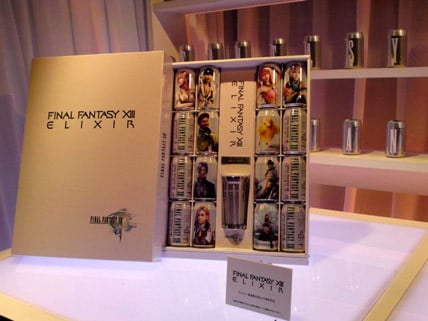
And now Final Fantasy XIII has that. To promote the game's December 17 release date in Japan, Square unveiled a series of Final Fantasy XIII Elixirs. Each of them is packaged with a collectible figure, and the drinks are apparently available in boxed gift sets as well, just in case you're tired of giving your aunt those cheese-and-sausage sampler packs every Christmas.
I wonder if anyone will actually consume these things. I can speak from experience, as a friend of mine gave me a Final Fantasy XII Potion energy drink years ago. It's still sitting, mostly full, in my closet, and not because of its collectible value.
NEWS
OKAMIDEN HAS A WOLF PUPPY, OTHER THINGS
 Capcom showed more of Okamiden, the DS-based Okami sequel, though the most important detail is this: it stars a puppy, or at least a puppy version of Amaterasu, the wolf-goddess protagonist of the original Okami. While the exact relationship between the two characters is under wraps, Okamiden is indeed a direct sequel, picking up in the world of Okami shortly after the first game's conclusion. With demons once again infesting the land, peach-goddess Sakuya seeks out a wolf-deity savior and finds only a pup, apparently named Chibiterasu. Chibiterasu. Awww.
Capcom showed more of Okamiden, the DS-based Okami sequel, though the most important detail is this: it stars a puppy, or at least a puppy version of Amaterasu, the wolf-goddess protagonist of the original Okami. While the exact relationship between the two characters is under wraps, Okamiden is indeed a direct sequel, picking up in the world of Okami shortly after the first game's conclusion. With demons once again infesting the land, peach-goddess Sakuya seeks out a wolf-deity savior and finds only a pup, apparently named Chibiterasu. Chibiterasu. Awww.
Okamiden takes after Okami's beautiful scenery and painting-driven gameplay, with the DS stylus used to simulate the strokes of a brush, as seen in an early trailer. Chibiterasu has several allies, and they'll join in fights and puzzling-solving challenges. In fact, one of Chibterasu's first partner is Kuninushi, son of a certain couple from the original Okami. He's already an improvement on the babbling, buglike Issun.
Oh yeah, remember how I fretted over Okami's sequel coming from people who had nothing to do with the original game? Well, the director of Okamiden, one Kuniomi Matsushita, helmed the Wii version of Okami. That ain't so bad.
GHOST TRICK ARISES FROM PHOENIX WRIGHT'S MIXED METAPHOR
 Though it's thoroughly overshadowed by Okamiden, Capcom's Ghost Trick is a fascinating new creation. Devised by Phoenix Wright scriptwriter Shu Takumi and action-game producer Hironobu Takeshita, Ghost Trick follows a newly murdered man named Sisel as his soul drifts through time and space, trying to solve his own murder. Things play out with the same graphic-adventure gameplay that propped up Phoenix Wright, though the premise alone makes Ghost Trick an inventive prospect. Perhaps Sisel is too streamlined a hero to draw in the same players that devour Phoenix Wright games, or perhaps he'll have a cast of rivals and supporters that stoke fan desires.
Though it's thoroughly overshadowed by Okamiden, Capcom's Ghost Trick is a fascinating new creation. Devised by Phoenix Wright scriptwriter Shu Takumi and action-game producer Hironobu Takeshita, Ghost Trick follows a newly murdered man named Sisel as his soul drifts through time and space, trying to solve his own murder. Things play out with the same graphic-adventure gameplay that propped up Phoenix Wright, though the premise alone makes Ghost Trick an inventive prospect. Perhaps Sisel is too streamlined a hero to draw in the same players that devour Phoenix Wright games, or perhaps he'll have a cast of rivals and supporters that stoke fan desires.
CONTRA REBIRTH IS OUT RIGHT NOW AS YOU READ THIS
Contra is known for many things, but it's often remembered primarily for making cheaters of us all. The larger Contra series spent the last 20 years rising and falling (and then rising) in quality, but everyone who played the original NES Contra likely recalls how to get 30 lives. Or 30 “guys,” as the uncivilized young barbarians of the 1980s called them.
Anyway, Contra Rebirth is out on WiiWare right now, and I hope it doesn't screw up our memories of Contra. Konami did that far too much already. Sure, the two PlayStation 2 Contra titles were decent and Contra 4 was impressive (if way too hard), but I'm still smarting over what happened in the 1990s with Contra: Legacy of War and C: The Contra Adventure.
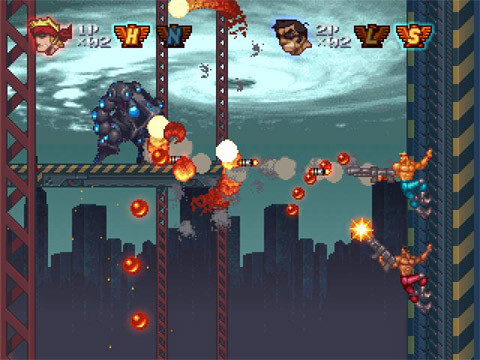
So far, Contra Rebirth has the right look: shirtless Schwarzenegger and Stallone clones blasting Aliens-style invaders and toting ridiculously huge hi-tech rifles. It's the 1980s that forged a generation.
IN BRIEF: NINETY-NINE NIGHTS II, JIGSAW ARENA, AND A SIGMA HARMONICS SEQUEL
I'd forgotten that anyone was making a sequel to Ninety-Nine Nights, the battlefield brawler that played much like Dynasty Warriors with darker fantasy themes. Apparently, I wasn't the only one, since the game slipped from a 2009 release date to some nebulous future debut. Microsoft, which released the original for the Xbox 360, recently threw the sequel to Konami for publishing duties. Feelplus, the Microsoft-backed studio behind Lost Odyssey and some parts of Blue Dragon Plus, is still working on the game, having taken over from the original developer, Phantagram.
I expect to see some new NIS strategy-RPG about every week, but Jigsaw Arena is a little different. It's a multiplayer puzzle title, it's based on an NIS creation from the 1990s, and it's the rare NIS arcade game. The gameplay is similar to the DS version of Jigsaw World: Daigekitou! Jig-Battle Heroes, released last month, though it's not clear how this new arcade version will handle the multiplayer angle. Oh, and Etna from Disgaea is in the game. As usual.
Sigma Harmonics is up there with Nanashi no Game as one of the most intriguing Square Enix titles that hasn't yet come to North America. However, the original DS-based Sigma, with its modern RPG setting and murder-mystery tale, will get a sequel called Sigma Harmonics Coda, judging by a recently uncovered Japanese trademark. Of course, it could just be a slightly enhanced version of the first game, as Square Enix is wont to make.
REVIEW: FATE/UNLIMITED CODES
 Developer: Cavia/Eighting
Developer: Cavia/Eighting
Publisher: Capcom
Platform: PSP (download only)
Players: 1-2
MSRP: $29.99
Fate/Unlimited Codes ignores two trends. Anime-based fighters rarely make it to North America without some mainstream push, and there's little of that here for Type-Moon's Fate/Stay Night line of visual novels and anime, no matter how much of a cult it commands in Japan. Anime-based fighters are also seldom complex, as they're designed for the undemanding casual player who's more concerned with playing Luffy or Naruto than mastering intricate combos. Fate/Unlimited Codes defies both conventions. It's here in English, and it's almost too complicated.
Not to suggest any mercenary intent on the part of Type-Moon, but Fate/Stay Night's premise lends itself quite well to a fighting game. In modern-day Japan, naive teenage hero Shiro Emiya and his more knowledgeable friend Rin Tohsaka are embroiled in the War of the Grail, a centuries-old tournament that draws servant warriors from beyond time and binds them to masters. Shiro gets Saber (or “the Saber,” since each summoned combatant comes from a certain archetype; it's a video game, remember), a semi-uptight blonde swordswoman with a really ridiculous backstory. And so they clash with all sorts of masters and servants, most of whom make it into Fate/Unlimited Codes as playable characters.
Fate/Unlimited Codes seldom looks all that different from other 3-D fighters on the PSP, as the heavyweights of Fate/Stay Night's cast confront each other against pretty (if unpopulated) backgrounds and hammer away with blades, bows, spears, and all sorts of energy attacks. At 14 fighters (plus a few unlockable ones), the roster is at standard size for a fighter, and while the characters all look fairly good in the game, their designs don't suggest a crazed Guilty Gear carnival of violence. When compared to other fighters and explicit adventure games, Fate/Stay Night's character designs are, in fact, shockingly reserved.
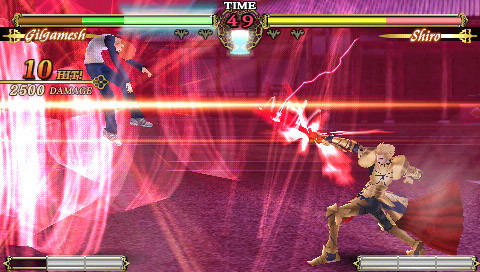
Yet Fate/Unlimited Codes is hardly standard-issue. Characters get three attack buttons of varying impact, plus a Reflect Guard button that gives you an opening if you tap it right when an opponent attacks. The Magic Burst move, accomplished by hitting all three attack buttons, regenerates your life meter and enables certain special attacks. It also leads to special counterattacks and defensive moves. All fighters get the full selection of maneuvers one would expect in a high-level fighter: guard cancels, move-linking, aerial recoveries (which I'm starting to demand in any fighting game), throw escapes, double-jumping, high-jumping, jump cancels, and lots and lots of combos. Fate/Unlimted Codes uses simple chains to start off its Slash Rave combo system, but a surprisingly wide range of attacks can be found.
A lot goes on beneath the surface of Fate/Unlimted Codes, and it can get quite demanding. Reflect Guards are tough to time properly, and the more complicated moves are challenges even in the tutorial mode. Then there's the grail icon sitting between the two combatants' life bars. It fills up with each hit given by either character, and whoever lands the blow that tops off the grail gets another temporary boost in power. Then the game lets you land the most damaging attacks, provided that your power gauge is full and that you can pull off a Magic Burst.
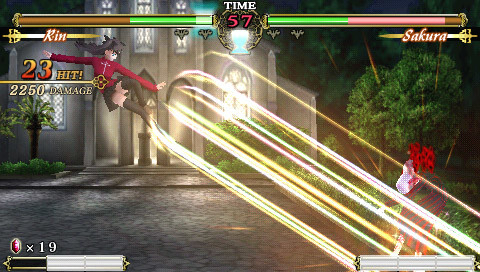
Yet the complexities are worth learning, as Cavia and Eighting thought out the characters fairly well. Most of them possess detailed assortments of attacks, featuring their true-to-the-anime weapons and specialties. Rin hurls fiery or freezing gems depending on the button pushed, Archer switches from swords to bows in the middle of battle, Sakura attacks with strips of her clothing, and Luviagelita hurls dark flames and slashes like a King of Fighters superstar (in comparison, leading heroine Saber is a bit boring). The character balance isn't quite even, but the sheer variety of combos and individual quirks makes each fighter intriguing.
For an game limited in plot, Fate/Unlimited Codes recreates the air of the Fate/Stay Night series quite well; the character models look impressive, and just about everything is accompanied by voice acting (all in Japanese, of course). The story mode itself is a breezier version of the broader Fate tales, with each character's personal struggles wrapped up in a dozen fights and a few conversations. However, the game stays true to Type-Moon's vision by having Saber and Shiro talk a bit too much.
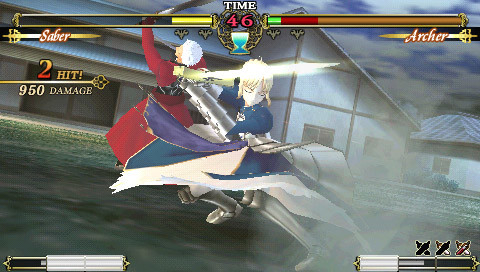
Compared to the arcade and PlayStation ports of Fate/Unlimited Codes, the PSP version is an impression adaptation. There's just one real difference: the PSP controls are simplified to remove diagonal requirements. See, in the original versions of Fate/Unlimited Codes, a move like Saber's First Air was a basic “fireball” motion: down, down-forward, and forward plus an attack button. In the PSP port, the move requires only a double-tap forward with the appropriate attack button. Just about every other move is similarly abbreviated, and if there's an option to change the control back to its older form, I haven't found it. It's an understandable tweak, considering the PSP's directional pad, but it alters the game's high-level play significantly and even removes some combos. Then again, those new to the game won't notice at all, and they'll likely prefer the new controls.
There's one more problem with Fate/Unlimited Codes: it's only available in North America as a $30 download. While I like the idea of obscure games translated and released as online-only downloads, thirty bucks is a bit steep in principle. Still, Fate/Unlimited Codes is easily worth that for the devoted fighting-game player and the Fate/Stay Night fan. It's faint praise to dub Fate/Unlimited Codes one of the best anime-based fighters around, as the game deserves better than to reign over no more than the latest licensed Shonen Jump brawls. It's an excellent fighter, period.
RELEASES FOR THE WEEK OF 9-13
BLEACH: THE 3RD PHANTOM The first two Bleach DS games, both great little fighters by Treasure, are tough acts to follow. So Sega didn't really try, and instead, they made a Bleach strategy-RPG. The 3rd Phantom looks much like any other modern grid-style battle simulator, though all of the squat characters come from Bleach's vast lineup. The game's version of that lineup adds two new faces, the twin soul reapers Matsuri and Fujimaru, and the game honestly tries to make them important to the Bleach franchise. Matsuri and Fujimaru each get a separate storyline, and around 50 characters join them in combat. While everyone's a big-headed sprite in the open field, all of the warriors carry out attacks in side-view scenes stuffed with over-the-top effects, not unlike the Super Robot Wars series. A battle-heavy “tower” mode awaits after the story mode ends, for those who demand replay incentives. At the very least, it's a better value than another one of the Bleach anime's badly drawn go-nowhere episodes.
|
MARIO & LUIGI: BOWSER'S INSIDE STORY Developer: Nintendo
Developer: Nintendo Publisher: Nintendo Platform: DS Players: 1 MSRP: $34.99 Both the title and the cover art seem vaguely unwholesome, but this is the latest in the Mario RPG line, a home for charming comedy in the face of the somewhat bland big-budget Mario offerings. It adopts the same 2-D look and turned-based battle system that drove previous Mario & Luigi titles, with a new emphasis on the turtle-king Bowser. As a strangely comical disease turns Mushroom Kingdom citizens into living balloons, Mario and Luigi find themselves miniaturized and stuck inside Bowser, who's become the unwitting servant of recurring villain Fawful. As Mario and Luigi make their way through Bowser's internal organs in some platform-jumping version of Fantastic Voyage or Innerspace (or Lifeforce, if you must couch everything as a video game), their actions affect Bowser in his player-controlled rampage through the Mushroom Kindgom. It's a clever idea in an already inventive series, and Bowser's Inside Story shows no sign of fumbling the execution.
|
NARUTO SHIPPUDEN: NINJA DESTINY 2 Developer: Tomy
Developer: TomyPublisher: Tomy/D3 Platform: DS Players: 1-2 (wireless) MSRP: $29.99
Portable Naruto games are mostly the domains of the franchise's fans, who possess the will needed to sit through a Naruto RPG or simplistic side-scrolling action game. Ninja Destiny 2, however, belongs to the highly approachable genre of fighting games. One doesn't need to care about Naruto canon to screw around with the 3-D combat or test out 34 characters from the series. Of course, if you do care, Ninja Destiny 2 has a fairly extensive story mode (for a fighting game, anyway) and a quest mode that involves randomly generated dungeons. It's also the third game to hit North America with Naruto Shippuden characters and storylines intact, and that certainly counts among the fans. |
Also Shipping: The critically hyped Scribblenauts for the DS. Looks great, but it's beyond this column's focus.
discuss this in the forum (53 posts) |
this article has been modified since it was originally posted; see change history
 Developer: Sega
Developer: Sega